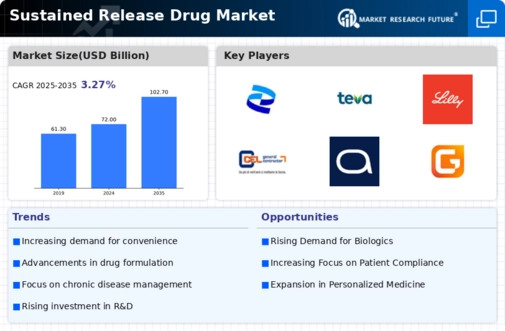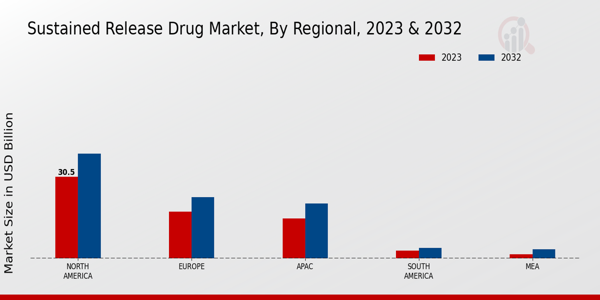Market Growth Projections
The Global Sustained Release Drug Market Industry is projected to experience substantial growth in the coming years. With a market value expected to reach 72.0 USD Billion in 2024 and further increase to 102.7 USD Billion by 2035, the industry is poised for a robust expansion. The anticipated compound annual growth rate (CAGR) of 3.27% from 2025 to 2035 underscores the increasing adoption of sustained release formulations across various therapeutic areas. This growth is driven by factors such as technological advancements, rising chronic disease prevalence, and an aging population, all contributing to the demand for effective drug delivery solutions.
Increasing Geriatric Population
The aging population worldwide is a crucial driver for the Global Sustained Release Drug Market Industry. Older adults often require multiple medications for various health conditions, making sustained release formulations particularly beneficial. These formulations reduce the frequency of dosing, which is essential for enhancing adherence among elderly patients who may struggle with complex medication regimens. The World Health Organization estimates that the global population aged 60 years and older will reach 2.1 billion by 2050, further emphasizing the need for effective drug delivery systems. This demographic shift is likely to contribute to the sustained growth of the market.
Rising Prevalence of Chronic Diseases
The Global Sustained Release Drug Market Industry is experiencing growth due to the increasing prevalence of chronic diseases such as diabetes, hypertension, and cardiovascular disorders. As these conditions require long-term management, sustained release formulations offer a viable solution by providing consistent drug delivery over extended periods. This approach not only enhances patient compliance but also optimizes therapeutic outcomes. For instance, sustained release formulations of metformin for diabetes management have shown improved glycemic control. The market is projected to reach 72.0 USD Billion in 2024, reflecting the growing demand for effective chronic disease management solutions.
Growing Demand for Personalized Medicine
The shift towards personalized medicine is driving innovation in the Global Sustained Release Drug Market Industry. Tailoring drug therapies to individual patient needs enhances treatment efficacy and minimizes adverse effects. Sustained release formulations can be customized to deliver specific dosages over time, aligning with the principles of personalized medicine. For instance, oncological treatments are increasingly utilizing sustained release systems to optimize drug exposure while reducing toxicity. This trend is likely to propel market growth, as healthcare providers seek more effective and individualized treatment options for patients.
Advancements in Drug Delivery Technologies
Technological advancements in drug delivery systems are significantly influencing the Global Sustained Release Drug Market Industry. Innovations such as nanotechnology, polymer-based systems, and microencapsulation techniques are enhancing the efficacy and safety of sustained release drugs. These technologies allow for precise control over drug release rates, minimizing side effects and improving patient outcomes. For example, the development of biodegradable polymers has enabled the creation of sustained release formulations that are both effective and environmentally friendly. As a result, the market is expected to grow, with projections indicating a value of 102.7 USD Billion by 2035.
Regulatory Support for Sustained Release Formulations
Regulatory bodies are increasingly recognizing the benefits of sustained release formulations, which is positively impacting the Global Sustained Release Drug Market Industry. Agencies such as the FDA and EMA have established guidelines that facilitate the development and approval of these drug delivery systems. This supportive regulatory environment encourages pharmaceutical companies to invest in research and development of sustained release drugs, leading to a broader range of therapeutic options for patients. As a result, the market is poised for growth, with a projected CAGR of 3.27% from 2025 to 2035, reflecting the ongoing commitment to improving patient care.















